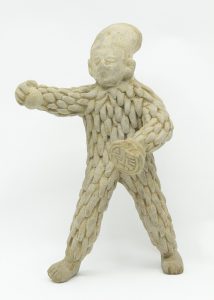
The Marjorie and Leon Marlowe Collection
Vanderbilt University. 1994.532
The Fine Arts Gallery is pleased to present a collection of ancient Latin American artifacts curated by undergraduate students as part of a semester-long course led by Dr. Markus Eberl, Associate Professor of Vanderbilt’s Department of Anthropology. The exhibition focuses on the connection between nature and the cultural practices of ancient Mesoamerican people.
The heat of sunrise and the growing rumble of jungle life signals morning. It is harvest time, and the smell of corn stalks being cut and removed from the chinampas is refreshing. Women chatter as they begin dyeing large bundles of agave fiber deep red, using the cochineal beetle, while men begin practicing in the nearby ball field, surrounded by the jungle on one side and market stalls on the other. Children run past, throwing a rubber ball to friends, their varied skull shapes signaling their varied progress in achieving the conical definition as a tribute to the corn goddess. This—the sounds, sights, and smells—is just a small glimpse into the daily life in Mesoamerica.
The artifacts on view come from different areas in Mexico and Central America, a geography that was once inhabited by highly developed and flourishing ancient civilizations hundreds to thousands of years ago. The exhibition elucidates the daily life, practices, and values held by ancient Mesoamerican people, as told through the lens of the small artifacts they left behind. These artifacts, which have been studied and contextualized by Vanderbilt students, help present a clearer picture of the environment of the ancient Americas. In this way, the exhibit also seeks to challenge the Westernized term “Noble Savages,” a reference to Western portrayals of ancient Mesoamerican peoples in a subdued and romanticized form. In reusing this out-of-date term, students aim to draw attention to its racially charged connotation while seeking to create an opposing representation of ancient Mesoamericans that focuses on their diversity of daily practices.
With the inclusion of interactive elements including (but not limited to) 3D artifact-replicas that invite hands-on discovery, we hope that you will join us in encouraging a multi-sensory exploration of Ancient Mesoamerica.
Refuting “Noble Savages”: Reflections of Nature Through Ancient Mesoamerican Artifacts is the result of a partnership between the Department of History of Art and the Fine Arts Gallery at Vanderbilt Univeristy. This student-curated exhibition comes from a semester of work carried out in a class titled “Exhibiting Historical Art—Daily Life in Mesoamerica” and was led by Professor Markus Eberl. The undergraduate students in this exhibition process include Baha Aydin, Kaitlin Joshua, Elsa Mueller, Kirsten Nafziger, Bella Smith, Sophie Stark, Yunyang Zhou, and Michelle Zhu. 3-D imaging and printing of ancient artifacts was made possible thanks to Anna Fisher, John Gore, Todd Peterson, Seth Smith, and Ken Wilkins at the Vanderbilt University Institute of Imaging Science. The exhibition is brought to the Vanderbilt University Fine Arts Gallery in part by the support of the Department of Anthropology, the Department of History of Art, and the Center for Latin American Studies.